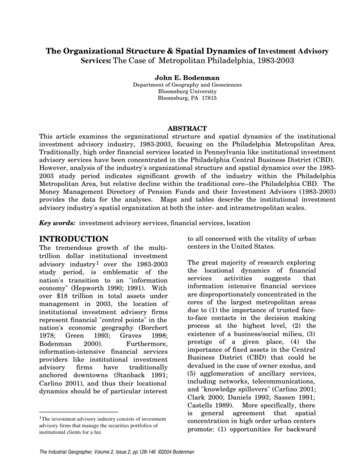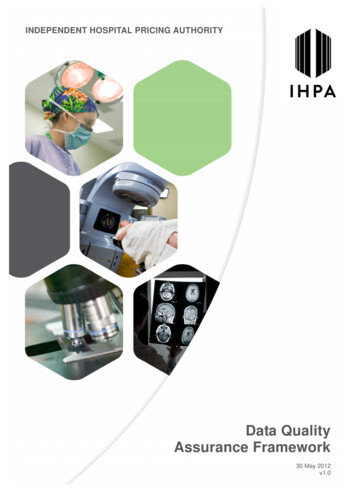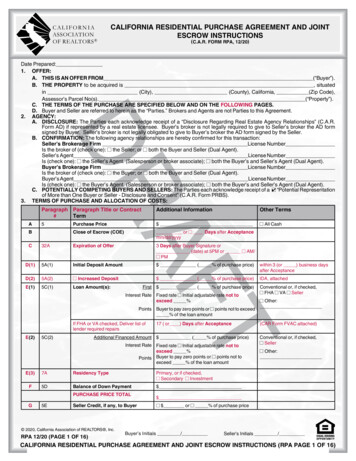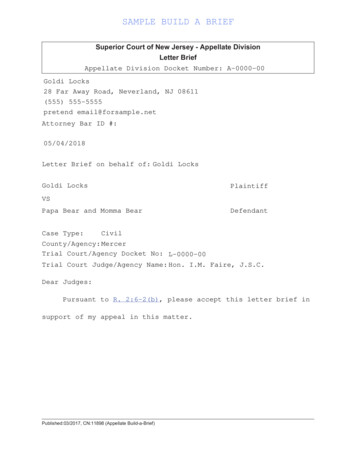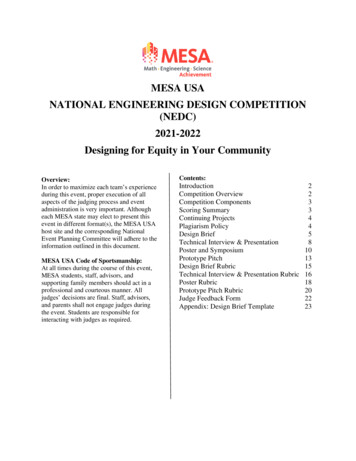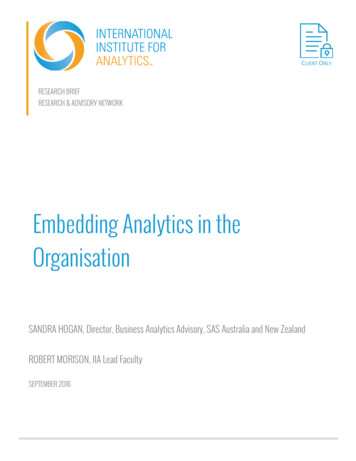
Transcription
CLIENT ONLYRESEARCH BRIEFRESEARCH & ADVISORY NETWORKEmbedding Analytics in theOrganisationSANDRA HOGAN, Director, Business Analytics Advisory, SAS Australia and New ZealandROBERT MORISON, IIA Lead FacultySEPTEMBER 2016
Embedding Analytics in the OrganisationTHE BIG IDEAS- An analytical enterprise embeds analytics in the- Analytics development roles centre on businessthinking and behaviour of individuals and the culture ofanalysis and modelling; operationalising analytics callsthe organisation.- Analytics should be seamlessly integrated intoeveryday workflows and decision processes, andbusiness people should be able to experience the resultsand benefits.- Organisations need “two-speed” data management andgovernance methods, traditional ones for reporting, andfor business applications, communication, and changeskills.- Shared business objectives and measures encouragethe use of analytics, demonstrate the value ofanalytics, and build the credibility of the analyticsgroup.more flexible ones for innovation and discovery.IntroductionWhen one says, “embedded analytics,” both businesspeople and analytics professionals tend to think firstof automated models and analyses embedded inbusiness processes, for example, to score customerpropensities or suggest offers to make. That’s onlypart of the story. An analytical enterprise — one thatmaximises the strategic, competitive and operationalvalue of its data and analyses — has analytics broadlyembedded in the thinking and behaviour of individualsand the culture of the organisation.In these enterprises, analytics represent not just abusiness and technology investment, but a pervasiveorganisational capability. People are comfortableworking with data and feel empowered to put it to use.Experimenting, innovating and improving are integralparts of their jobs. Making fact-based and analyticaldecisions is simply how the organisation works.CEOs and other senior executives take the lead, notonly in sponsoring strategic analytics initiatives, butalso through their behaviour and example asiianalytics.comCopyright 2016 International Institute for Analyticsanalytical leaders. The board pays attention to howwell the enterprise leverages data and analytics, andhow it does so relative to the competition. And thebusiness actively owns its data and analytics.Technologists provide essential skills, but businesspeople have a strong sense of what analytics can do,and they take the lead in identifying targetapplications and business ambitions.That’s how things work in an organisation with deeplyembedded analytics. Such organisations are theexception rather than the rule. Others may spendsignificant money on analytics software and services— Gartner sizes the 2016 global market in analyticsand business intelligence at almost 17 billion, and theAustralian Computer Society estimates the Australiannational market at AUS 670 million. Yet they still taketoo many business decisions based on faultyspreadsheets, outdated rules or pure instinct.How can an organisation embed analytics morethoroughly? Although the organisations I’ve workedwith have their unique challenges, I find five commonsuccess factors. Executing on them will facilitate and2
Embedding Analytics in the Organisationaccelerate embedded analytics — and drive morevalue from the enterprise’s analytics investment.NO. 1. WORK THE DATA — BUT DON’TOVERENGINEER ITData is at the core of the contemporary business.Executives are learning to think of it as a strategicasset, and an analytical enterprise wants to encouragegood and active use of the data. Yet organisationshesitate to put their data to work, both on the frontlines and in analytics applications, for three commonreasons. One, they fear that the data may beinaccurate or incomplete, and people may makemistakes or poor decisions using it. Two, they haveonly one way of working with data, predicated on tightcontrols to maximise accuracy. And three, they oftenhave concerns about data protection and privacy.preprocessed. Contrast that with the accuracy neededfor legal and regulatory compliance or customer andtransaction data at customer touch points. There youneed data to be validated and staged ready for specificuse.Organisations need to shift how data is provisionedand consumed. They need “two-speed” datamanagement and governance methods. The volume ofdata is different, the speed of data movement andanalysis are different, the technologies are different,and the intent is different. Traditional datamanagement and governance processes are neededfor reporting and understanding what’s happened; theoutput is facts as best we can establish them. Newprocesses are needed for innovation and discoveringwhat’s possible; the output is probabilities and oftenthe next question to explore. There’s no need tooverengineer the data for the latter.You need the right data management strategy toachieve your analytics objectives, and a contemporarydata strategy begins with recognising how theexponential increase in available data has changed thegame. Many data models and methods are out of date,no longer feasible from time and cost perspectives,and no longer relevant with the high volume of databeing generated. It’s simply impossible to get all thedata “right” by traditional standards before putting itto work (though some organisations still try). Instead,be realistic and build your data and analyticscapabilities in concert.Businesses need both speeds, one favouring precisionand control where data use is predetermined, theother favouring agility and flexibility where data canbe used in many new ways. One asks, “How do we getthe data right?” and the other, “What can we learnfrom the data available?” When an organisation isstuck at the traditional speed, it helps to talk throughthe issue of data sufficiency. But the breakthroughcomes when you test- drive at the new speed bytackllng a recalcitrant business problem anddiscovering a new solution. That frees up people’sthinking about data and its use, and it builds moreconfidence in advanced analytics.Big data changes the definition of data quality. Formany analytical purposes, the data doesn’t have to becomplete, accurate, perfect. It just needs to besufficient. Big data applications can find patternslooking across vast data sets in their raw form evenwhen much of the data is imperfect at the “recordlevel.” In fact, it’s easier to discover hitherto unknownswith data that has not been “cleansed” or otherwiseFinally, a word on data privacy and security. They areabsolutely essential and must be addressed regardlessof how they are used. Approaches will differ betweenthe two speeds of data management. For example,high-volume, discovery-type analytics might best useanonymised data. Unfortunately, people too oftenmake privacy and security concerns an excuse not toiianalytics.comCopyright 2016 International Institute for Analytics3
Embedding Analytics in the Organisationdo something that’s in fact feasible. Privacy andsecurity are hygiene factors, and any kind oforganisation — public, private, nonprofit — canimplement strong security methods and comply withprivacy laws and still leverage data and analyticsextensively and effectively.NO. 2. OPERATIONALISE ANALYTICS INWORKFLOWS AND DECISION PROCESSESFor analytics to be deeply embedded and widelyemployed across an organisation, they must become aregular part of how people work. Success dependsmore on how easily the business can consume theanalytics output than on how clever the modellingtechniques are. Analytics should be seamlesslyintegrated into everyday workflows and decisionprocesses. Business people should be able to workdirectly with the analytics “products” without havingto seek help or explanation from the professionalanalysts and model builders. They should be able tosee the results and benefits for themselves.To operationalise and scale up analytics, anorganisation must automate as much as possible. Acall center representative should be automaticallyserved best-offer or best-action recommendationswhile on the line with the customer. Behind thescenes, the models are profilling customers,generating propensity scores and selecting amongoptions to offer.There’s an important distinction between analytics indevelopment and analytics in operation. Developmenthappens in a “sandbox” where analysts canexperiment, pilot, refine and validate models ofbusiness processes and decisions. In someorganisations, methods are extremely agile: crossfunctional business, analytics and technologist teamswork for prescribed periods (for example, two weeks)iianalytics.comCopyright 2016 International Institute for Analyticsrunning innovation sessions and rapidly prototypingand testing solutions for business problems. Suchdedicated and intensive efforts have the freedom andflexibility to envision and experiment outside theconstraints and culture of the day-to-day business.When models are getting ready for operation, theprocess necessarily becomes more formal. Data andanalytical inputs and outputs are automated forrepeatable performance and integration into businessworkflows. Measuring the performance of modelsshould also be automated, so analysts can monitorand improve models as needed.Analytical organisations respect the distinctionbetween development and operations through clearlydefined roles, processes and capabilities across thefull analytics life cycle — from conceptualization andprototyping to ongoing model monitoring andmanagement. Development roles center on businessanalysis and modelling skills. Operational roles centeron business applications, communication, andchange. Development is about provisioning.Operationalising is about consumption. In many cases,analytics specialists try to bring all the skills and do allthe work across the analytics life cycle. However, asbusiness people and IT technologists become morefluent in analytics, more specific roles andresponsibilities appear across all stages of the lifecycle. Having clear roles and specialist skills tooptimise outcomes makes for better analyticalproducts and greater confidence in using them.Confidence is the name of the game, and perhaps themost fundamental measure of how effectivelyanalytics are operationalised. The call centerrepresentative doesn’t need to understand thealgorithms, but does need to know enough about theunderlying data and logic to find the modelsdependable, as well as see the pragmatic results offollowing automated recommendations. Analytics4
Embedding Analytics in the Organisationproducts should provide the right amount ofexplanation to build and continuously reinforce theuser’s confidence. Fortunately, people’s experiencewith Amazon and Netflix is making them moreaccustomed to behind-the-scenes algorithms andmore attuned to how well they are working. Weappreciate the benefits of having relevant offerspresented to us.NO. 3. MEASURE TO BUILD MOMENTUMMeasuring the performance of analytical models andtheir contribution to specific business objectives is keyboth to improving over time and to buildingmomentum for using analytics. If you want people toline up for your analytical assets and insights, and youwant to win over the skeptics who are accustomed tomaking decisions based on gut feel, you need to beable to measure the value that analytics can deliver.Analysts and their leaders are sometimes hesitant tomeasure value in business terms and to commit toimprovement objectives, especially financial ones. Butthey should. Analytics may be a new component of thebusiness process, and the opportunity for businessimprovement may be a rough estimate, but it’s stillessential to have a consistent framework of metricsand targets from the start: “What is the startingposition, how do we define success, and how do wemeasure performance and improvement goingforward?”Because analytics enable people to look at thebusiness differently, creative new metrics enter themix, and the analysts may take the lead in definingthem. But always start with a clear baseline ofestablished business metrics against which tomeasure progress. For example, new analytics mayenable calculation of net promoter scores andmeasurement of profit-by-customer, while theiianalytics.comCopyright 2016 International Institute for Analyticsbaseline includes customer retention and revenueper-customer.Metrics and the roles in defining them will evolve asthe organisation grows more analytical. In working oncustomer campaigns, marketing may initially defineoffers and select channels, and the analytics team mayfocus on targeting methods. Over time, measurementand analyses can become more granular, such asspecific offer conversion rates by channel. Then offersand channels may be determined more analytically,and the entire process can be integrated andoptimised. Throughout this evolution, revenue andcustomer relationship measures and targets should beshared by the marketing and analytics teams, andresults should be visible to the organisation at large.In short, robust measurement is essential to managingbusiness change and improving the accuracy ofmodels. Shared measures and objectives encourageuse of analytics, demonstrate the value of analyticsand build the credibility of the analytics group. Don’tshy away from financial targets. And don’t makemeasurement an afterthought and start to work on itmidstream — that dilutes the opportunity to drivecollaboration and deliver visible value.NO. 4. FOCUS ON BUSINESS AS WELL ASTECHNICAL SKILLSFrom universities on, analytics has been treated as atechnical career. Analysts are engineers andmathematicians, interested in algorithms, datascience, and the new technologies and methods infields like machine learning. But when it comes toembedding analytics in an enterprise, acomplementary set of soft skills and businessknowledge is just as important as the technical skills.Analysts need strong communication skills to translatecomplex methods and processes into simple terms. To5
Embedding Analytics in the Organisationintegrate analytics into workflows, they need toanticipate how business people and processes willexecute on analytical outputs.The most versatile analysts embrace the businessknowledge that comes their way. The more theyunderstand the business, the easier it is to introduceanalytical outputs into business processes, toarticulate the benefits of analytics, and to effectbusiness change. They spend plenty of time in thebusiness, both understanding how processes workand introducing analytics outputs to make theprocesses work better.If the domain is talent analytics, the analysts spendtime with HR professionals exploring how they recruit,look at staff profiles and identify high performers.What challenges do they face? What problems havebeen “too complex to solve” in the past? What are thespecific pressure points? For example, when looking atattrition among high performers, what are the trends,what are the patterns in their profiles, can we identifytriggers or markers for attrition, and can we predictwho might be at risk of leaving? The fundamentalcapability here is asking the right business questionswhile recognising what analytics can do.Because it’s difficult to find the technical and businessskills in one person, organisations compensate withcross-functional team structures and with “translator”roles for people who are conversant but not expert onboth sides. However, organisations should also striveto develop analysts with the crossover skills. Somepeople’s personal passion will remain technical, butothers enjoy being “out in the business.” And theleaders of analytics groups must be business focused.Look at how leadership roles in IT have evolved towardthe business side in recent years — the same ishappening with analytics leaders.iianalytics.comCopyright 2016 International Institute for AnalyticsTherefore, senior analysts and analytics leaders mustcontinuously hone their skills at reading andinfluencing their business counterparts. Is this generalmanager more a data person or a visual person? Whatis it I need to put in front of her? Deliver a flashypresentation, or sit down with a spreadsheet and talknumbers? How does she respond to businesschallenges and change? How aggressive and creativedoes she want to be with analytics? Analytics leadersare also responsible for the skills mix, hiring peoplewith business and technical backgrounds, and helpingstaff develop their business knowledge and consultingskills — how to ask questions and solve problems inbusiness terms. It’s a good sign that universityprograms in analytics are placing more emphasis onbusiness-side skills.NO. 5. CHANGE THE CULTURE AS WELL AS THEPROCESSESEmbedding analytics in an organisation entails twokinds of change management. The first is conventionalchange to business processes and decisions: “How amI going to work differently and achieve my goals indifferent ways with the help of analytics?” The secondis more a profound and cultural change: “How do Ithink about business problems and the data needed tosolve them? How empowered am I to explore the dataand innovate with analytics?” The business processchanges can often happen quickly, one application ata time. The cultural changes run deeper and take time,but there are specific ways to accelerate them: Publish the strategy. The enterprise should havea concise “strategy on a page” for how it leveragesanalytics in pursuit of strategic objectives, plus a“strategy on a page” for each business domainusing analytics to improve specific processes anddecisions. Together, these documents tie analytics6
Embedding Analytics in the Organisationinitiatives to business objectives and enableindividuals to see how changes to their work fitinto the big picture. They also give the CEO andother executives a way to communicate: “This iswhy and how we are building data and analyticsinto our business functions and ambitions.” Publish the catalogue. Let the enterprise knowwhat kinds of analytical capabilities and modelsare available by maintaining a catalogue ofanalytics products and services. We can dopropensity modelling, risk management modelsand forecasting — with specific examples of eachand the potential benefits. This educates peopleand gets them thinking about new possibilities. Italso reduces duplication of effort across a complexorganisation when everyone has a better idea ofwhat may already be “on the shelf.” Educate employees. Direct forms of educationcan also shape people’s appreciation of thebusiness potential of data and analytics. In a fewanalytically driven organisations, all employeesreceive training, typically online, in the data assetsand analytical tools associated with their roles.Part of every new employee’s orientation is aroundhow the organisation uses, protects and values itsdata. Adjust the measures. I’ve mentioned theimportance of shared objectives and measures inanalytics projects to drive collaboration andexecution. Business people should also bemotivated more broadly to leverage their data andbe analytical in their decision-making. HR can helpmake this happen through the KPI system forindividual employees. Just as industrialcompanies may include objectives around safetyfor every employee, an analytical enterprise williianalytics.comCopyright 2016 International Institute for Analyticsinclude objectives around data-driven behaviorsand actions. Leverage executive sponsorship. Changemanagement always benefits from strongexecutive commitment and championing. But withanalytics, this has an added dimension. Businessleaders don’t just sponsor projects andcommunicate the strategic importance ofanalytics — they also set the cultural tone by theirown data-driven behaviours and use (or nonuse)of analytics. Ideally, executives’ experiences beinganalytical in areas like finance and supply chaintranslate into all facets of the business. And thegood example they set cascades through theorganisation. Note, however, that this cascadetypically becomes diluted two or three levelsdown, so the other actions just listed remainessential.Well-intentioned business leaders may still have asmuch difficulty as others do in becoming more datadriven. Think about how the telco industry worked adozen or so years ago in the earlier days of mobilephones. The whole market was expanding, andbusiness leaders could pretty much follow their gutfeel about where to expand the network next to attractmore account activation. Today the industry is fiercelycompetitive, and yesterday’s procedures no longerapply. Companies must focus on and sort throughcustomer needs and preferences, the variety ofdevices and apps and services, and how to engageprospects and customers. They have to do big dataanalytics. Yet, instead, executives’ experiences andinstincts sometimes prevail.GETTING GOINGTwo big questions when embedding analytics in anorganisation are where to start and how aggressively7
Embedding Analytics in the Organisationto proceed. In a large and complex enterprise,analytics are not one-size-fits-all, and big analyticsprograms tend to founder. The more common andreliable procedure is to start in multiple parts of thebusiness that offer favourable conditions — a clearproblem to address, some decent data and awillingness to address the problem differently. Thisapproach generates early successes and demonstratesa variety of use cases for analytics. It lays the groundfor gradual expansion and rollout to other parts of thebusiness. Culture that puts data and analytics at theheart of both everyday work and businessstrategy.Additional InformationTo learn more about this topic, please visit:http://www.sas.com/en d-analytics.htmlAt the same time, however, there’s value in beingselectively aggressive. Find one or two areas where thebusiness is underperforming on key dimensions or isfacing unfamiliar competitive threats, where processesneed to be disrupted and leaders are willing to takesome risks in pursuit of big returns. If you concentrateanalytical energies there and deliver breakthroughresults, they will serve as a wake-up call to the rest ofthe enterprise, and the demand for better data andanalytical solutions will accelerate.Whether you follow one of those paths or both, keep inmind the success factors I’ve discussed. They are thehallmarks of an analytically mature organisation: Strong data strategy with “two speeds” of datagovernance and management. Automated analytics embedded in businessprocesses and decisions. Robust and innovative measurement ofbusiness and analytics performance and value. Analytics teams working in the business, notback of the house.iianalytics.comCopyright 2016 International Institute for Analytics8
Embedding Analytics in the OrganisationAbout the AuthorsSANDRA HOGANSandra Hogan leads a team that leverages SAS analytics technology, expertise andresources to develop and implement strategies for operational improvement andcompetitive gain. Her team adds value by working alongside customers’ own businessmanagers and IT professionals, and taking a holistic view that includes their people andprocesses, as well as their data and technology infrastructures. The goal of the SASBusiness Analytics Advisory is to help customers succeed with solutions that deliverinsights for fast, best practice decision making.Sandra Hogan joined SAS as a Senior Analytics Advisor in April 2013, with her focus onimproving analytics processes for SAS clients and advising on the key capabilities theymust develop in order to realise maximum benefit from their investment in businessanalytics.Her most recent success was the design, development and launch of the company’s SASResults business unit. The unit offers Analytics-as-a-Service and delivers programs thatsupport the delivery of large-scale implementation projects which focus on cloud-basedtechnologies to drive analytics value.“Business analytics is much more than data and technology,” Ms. Hogan said. “To realisethe true value of business analytics you need to align strategy with business processesand develop the core competencies of your people. Analysts need to know whatquestions to ask and then how to act on the insights before the benefits are evident.“I am passionate about helping people in organizations with change, particularlyenhancing skills to solve business problems with data. Our BAA team consults with clientsto help efficiently match the best analytical solutions to pressing business needs andintegrate them with business processes and systems. We show our customers howapplications and processes can be fine-tuned to address unique challenges andopportunities, and be continuously re-evaluated for optimum effectiveness.”Sandra Hogan began her analytics career with Victoria’s Transport Accident Commission.She spent ten years at Telstra where she rose to be Director of Customer Intelligencebefore joining Ernst & Young as an Executive Director. At EY she led analytics-embeddedinitiatives to improve customer value optimization and marketing solutions. She holds aBSc in Mathematics and Statistics from Monash University.iianalytics.comCopyright 2016 International Institute for Analytics9
Embedding Analytics in the OrganisationROBERT MORISONRobert Morison serves as Lead Faculty for IIA’s Enterprise Research Subscription. Anaccomplished business researcher, writer, discussion leader, and managementconsultant, he has been leading breakthrough research at the intersection of business,technology, and human asset management for more than 20 years. He is co-author ofAnalytics At Work: Smarter Decisions, Better Results (Harvard Business Press, 2010),Workforce Crisis: How to Beat the Coming Shortage of Skills And Talent (HarvardBusiness Press, 2006), and three Harvard Business Review articles, one of which receiveda McKinsey Award as best article of 2004. He holds an A.B. from Dartmouth College andan M.A. from Boston University.IIANALYTICS.COMCopyright 2016 International Institute for Analytics. Proprietary to subscribers. IIA research is intended for IIA members only andshould not be distributed without permission from IIA. All inquiries should be directed to t 2016 International Institute for Analytics10
Embedding Analytics in the Organisation RESEARCH BRIEF RESEARCH & ADVISORY NETWORK SANDRA HOGAN, Director, Business Analytics Advisory, SAS Australia and New Zealand
